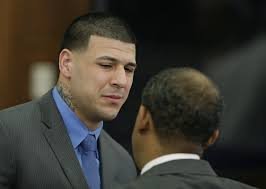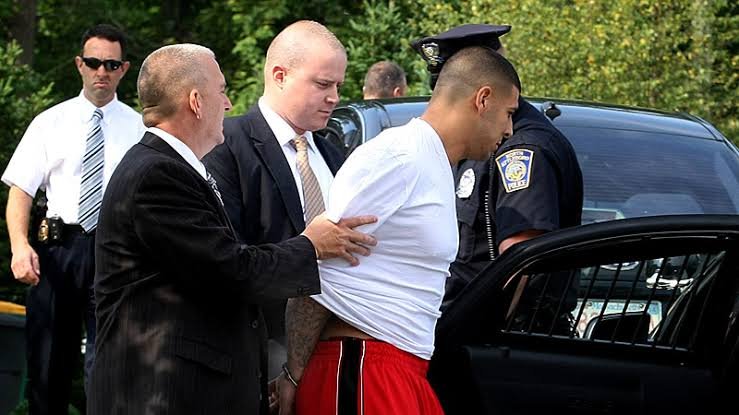
Introduction

Aaron Hernandez once stood at the peak of professional sports. As a star tight end for the New England Patriots, fans expected him to dominate the NFL for years. Instead, his career and life collapsed under the weight of criminal charges. Hernandez faced multiple accusations, including murder and weapons violations, that ultimately sent him to prison for life.
This article explores what Aaron Hernandez was charged with, how prosecutors built their case, and why his story ended in tragedy. Along the way, you will see how early warning signs, violent behavior, and legal entanglements shaped the downfall of a player once destined for greatness.
1. Early Promise, Early Trouble
Aaron Hernandez was born on November 6, 1989, in Bristol, Connecticut. He grew up playing football and quickly developed into a standout athlete. At the University of Florida, he won a national championship and became an All-American tight end. In 2010, the New England Patriots drafted him, pairing him with Rob Gronkowski to form one of the most explosive tight end duos in NFL history.
However, trouble followed Hernandez off the field. In 2007, police questioned him about a double shooting near Gainesville, Florida. Authorities never charged him, but the incident raised red flags. He also faced allegations of violence, including an alleged assault during his college years. Although his athletic talent kept him in the spotlight, his behavior away from the field hinted at deeper issues.
2. The Charges That Changed Everything
The Murder of Odin Lloyd
On June 17, 2013, the body of Odin Lloyd—a semi-pro football player—was found near an industrial park just a mile from Hernandez’s home. Lloyd had been dating the sister of Hernandez’s fiancée, which made their connection deeply personal. Investigators discovered text messages, destroyed surveillance footage, and ballistic evidence linking Hernandez to the killing.
On June 26, 2013, authorities arrested him. Prosecutors charged Hernandez with first-degree murder and five gun-related offenses: carrying a firearm without a license, carrying a large-capacity firearm, possessing a firearm without a Firearm Identification (FID) card, and possessing ammunition without an FID card. The combination of murder and weapons charges shocked the sports world and ended his NFL career overnight.
The 2012 Double Homicide
In addition to the Lloyd case, prosecutors linked Hernandez to another violent crime. In May 2014, a grand jury indicted him for the 2012 murders of Daniel de Abreu and Safiro Furtado in Boston. The indictment included two counts of first-degree murder, three counts of armed assault with intent to murder, and one weapons charge. Investigators claimed Hernandez opened fire after a nightclub altercation.
These charges painted a picture of escalating violence and reckless behavior that contrasted sharply with his public image as a professional athlete.
3. Trials, Convictions, and Sentencing
The Odin Lloyd Trial
In January 2015, Hernandez’s trial for Odin Lloyd’s murder began. Prosecutors presented evidence of motive, surveillance footage, text messages, and witness testimony. On April 15, 2015, the jury found Hernandez guilty of first-degree murder. The conviction carried a mandatory sentence of life in prison without the possibility of parole.
The Double Murder Acquittal
Two years later, in March 2017, Hernandez stood trial for the 2012 Boston killings. After weeks of testimony, the jury acquitted him of both murder counts in April 2017. Although this verdict offered him a small legal victory, it did not erase his life sentence for Odin Lloyd’s murder.
Legal Aftermath
For a brief period, Hernandez’s conviction for Lloyd’s murder was vacated due to a legal technicality known as “abatement ab initio.” This rule erased convictions if a defendant died before exhausting all appeals. However, in March 2019, Massachusetts’ highest court reinstated his conviction, ensuring that history would record him as guilty of Lloyd’s murder. Aaron Hernandez charges.
4. Incarceration and Final Tragedy
Life in Prison
After his conviction, officials transferred Hernandez to Souza-Baranowski Correctional Center, a maximum-security facility in Massachusetts. There, he lived in a single cell. Reports described him as manipulative, often charming correctional officers to gain small privileges. Yet despite occasional leniency, he lived under constant restrictions, isolated from family, teammates, and the life he once knew.
Suicide and Its Aftermath
On April 19, 2017, just days after his acquittal in the Boston double murder case, correctional officers found Hernandez dead in his prison cell. He had hanged himself with a bedsheet. He was 27 years old.
After his death, researchers studied his brain and diagnosed him with chronic traumatic encephalopathy (CTE). The severe damage raised new questions about the link between repeated head trauma, mental health issues, and violent behavior in athletes. Aaron Hernandez charges.
5. Legacy and Broader Implications
Aaron Hernandez’s downfall illustrates the dark side of professional sports. His talent promised fame, wealth, and championships, yet his violent actions destroyed everything. His case also highlighted serious issues:
-
The potential impact of brain injuries on behavior.
-
The importance of mental health support for athletes.
-
The responsibility of teams and leagues to monitor players’ conduct.
In 2024, FX released American Sports Story: Aaron Hernandez, a series that examined his childhood, career, crimes, and struggles with identity. The show reignited debate about whether systemic failures—from family trauma to the NFL’s culture of violence—played a role in his tragic end. Aaron Hernandez charges.
FAQs
Q1: What charges did Aaron Hernandez face?
He faced first-degree murder for killing Odin Lloyd and five related firearms charges. Later, prosecutors indicted him for the 2012 double homicide of Daniel de Abreu and Safiro Furtado.
Q2: Why did Hernandez receive a life sentence?
Massachusetts law mandates life without parole for first-degree murder. Since the jury found him guilty of Lloyd’s murder, the judge had no choice but to impose that sentence.
Q3: Was Hernandez guilty of the 2012 Boston double murders?
No. In 2017, a jury acquitted him of both counts, although he still served a life sentence for Odin Lloyd’s murder.
Q4: What evidence linked him to Odin Lloyd’s killing?
Investigators found surveillance footage, text messages, and ballistic evidence. They also uncovered that Hernandez destroyed his home security system, which prosecutors argued showed guilt.
Q5: Did Hernandez die in prison?
Yes. On April 19, 2017, officials found him dead by suicide in his cell.
Q6: What did doctors find after his death?
A study of his brain revealed severe CTE, which sparked renewed conversations about football-related brain injuries and their impact on behavior. Aaron Hernandez charges.
Conclusion
Aaron Hernandez’s life story remains one of the most shocking in sports history. He rose from a small-town kid to an NFL star, only to lose everything because of his own violent actions. Prosecutors charged him with murder, weapons offenses, and even multiple homicides. His conviction for Odin Lloyd’s death ensured that he spent the rest of his short life behind bars.
Although he briefly tasted freedom in court with his double murder acquittal, his suicide in 2017 ended his story abruptly. The posthumous discovery of CTE added another layer to his legacy, forcing society to ask hard questions about the role of brain trauma, mental health, and accountability in professional sports.
Aaron Hernandez’s rise and fall serve as a warning about wasted potential and the devastating consequences of violence.
